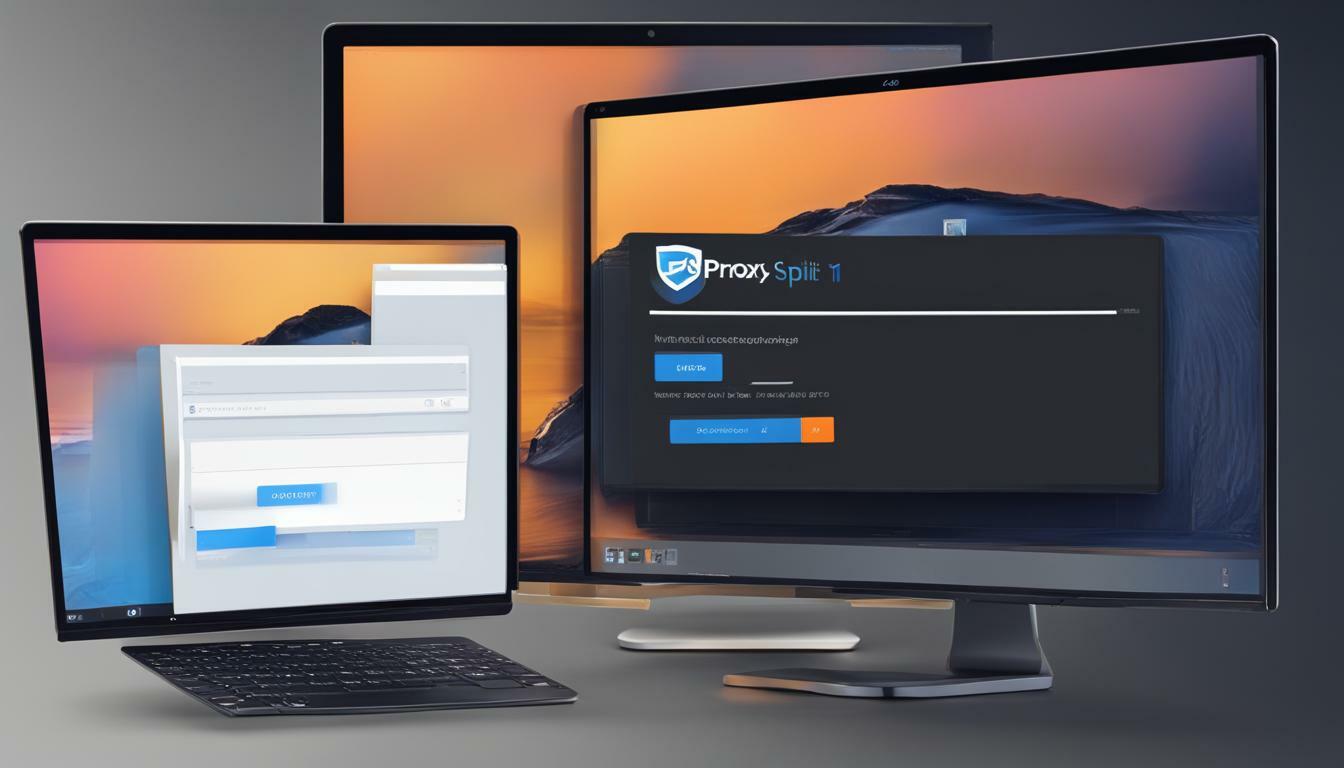In this simple guide, we will explore the concepts of HTTP proxy and HTTPS proxy, and how they function as proxy servers. HTTP (Hypertext Transfer Protocol) is a widely adopted protocol that allows files to be transferred over the internet, while HTTPS (Hypertext Transfer Protocol Secure) is a secure version of HTTP that encrypts data transmission. An HTTP proxy server acts as an intermediary between the client browser and the destination web server, providing benefits such as bandwidth savings, caching, and security measures.
It can be used for content restrictions, bypassing website restrictions, and ensuring privacy by masking IP addresses. HTTPS proxies, on the other hand, handle encrypted data transmission using SSL (Secure Sockets Layer) or TLS (Transport Layer Security) protocols. They provide added security by encrypting the data and authenticating both the client and server.
While HTTPS proxies can be more secure, HTTP proxies can still be used for HTTPS traffic. HTTP proxies can be set up as TCP proxies using the CONNECT command, which allows for the secure relay of HTTPS data. Using an HTTP proxy for HTTPS requests can provide security benefits, although it may require additional configuration. Both HTTP and HTTPS have their pros and cons, and their usage depends on the specific needs and requirements of the application or user.
Key Takeaways:
- HTTP proxy and HTTPS proxy are both types of proxy servers that act as intermediaries between clients and web servers.
- HTTP proxy offers benefits such as bandwidth savings, caching, and security measures.
- HTTPS proxy ensures secure data transmission by using SSL or TLS protocols to encrypt and authenticate connections.
- HTTP proxies can handle HTTPS traffic by setting up TCP proxies using the CONNECT command.
- Using an HTTP proxy for HTTPS requests can provide additional security benefits, but may require additional configuration.
What is HTTP Proxy?
An HTTP proxy acts as an intermediary between a client browser and a destination web server, playing a crucial role in facilitating internet communication. It receives requests from the client browser and forwards them to the web server, acting as a middleman in the process. This allows the proxy server to handle all incoming and outgoing traffic, providing various benefits to both clients and servers.
One of the key advantages of using an HTTP proxy is bandwidth savings. By caching frequently accessed web content, the proxy server can store copies of web pages and serve them directly to clients, reducing the amount of data transmitted between the client and server. This not only improves performance but also saves bandwidth, especially in situations where multiple clients access the same content.
Another significant benefit of an HTTP proxy is enhanced security. The proxy server can implement security measures to protect the client’s privacy and prevent unauthorized access to sensitive information. Additionally, it can help bypass content and website restrictions by routing traffic through different IP addresses or regions, granting users access to blocked or restricted content.
What Happened to Unordered List here? Not Relevant to Section 2
| Pros of Using HTTP Proxy | Cons of Using HTTP Proxy |
|---|---|
| Improved performance through caching | Potential latency due to additional network hops |
| Enhanced security and privacy | Possible compatibility issues with certain websites or applications |
| Bypassing content and website restrictions | Can slow down the browsing experience if not properly configured |
In conclusion, HTTP proxies serve as essential tools in internet communication. They act as intermediaries, providing benefits such as bandwidth savings, enhanced security, and the ability to bypass content restrictions. While they may have some drawbacks, such as potential latency or compatibility issues, the advantages outweigh the disadvantages for many users. By understanding how HTTP proxies work and their potential applications, users can optimize their online experience and ensure a secure and efficient browsing environment.
Benefits of Using an HTTP Proxy
By using an HTTP proxy, users can experience benefits such as bandwidth savings, caching for faster access to web content, and enhanced security measures. An HTTP proxy acts as an intermediary between the client browser and the destination web server, optimizing internet communication and improving overall performance.
One of the significant advantages of using an HTTP proxy is bandwidth savings. The proxy server can cache frequently accessed web content, reducing the amount of data that needs to be transferred between the client and server. This caching mechanism allows subsequent requests for the same content to be served from the proxy’s cache, resulting in reduced bandwidth usage and faster access to web pages.
In addition to bandwidth savings, an HTTP proxy also offers enhanced security measures. The proxy server can act as a barrier, filtering out potentially malicious traffic and protecting the client’s network from external threats. It can also enforce security policies, such as blocking access to certain websites or controlling user permissions, ensuring a more secure browsing experience.
| Benefits of Using an HTTP Proxy: |
|---|
| Bandwidth savings |
| Caching for faster access to web content |
| Enhanced security measures |
In summary, utilizing an HTTP proxy can bring several benefits to users. With bandwidth savings, caching for faster access to web content, and enhanced security measures, an HTTP proxy enhances the overall internet experience while optimizing performance and protecting against potential threats.
Content Restrictions and Bypassing Website Restrictions with HTTP Proxy
HTTP proxy servers can be utilized to overcome content restrictions and circumvent website blocks, enabling users to access restricted or blocked websites. Online content restrictions are often imposed by governments, organizations, or internet service providers for various reasons, including censorship, copyright enforcement, or security concerns. However, with the help of an HTTP proxy, users can bypass these restrictions and gain access to the content they desire.
When a user connects to the internet through an HTTP proxy, their web traffic is routed through the proxy server before reaching the destination website. By doing so, the proxy can intercept and modify the requests made by the user’s browser. This allows the proxy server to request the restricted content on behalf of the user, effectively bypassing any content restrictions imposed by the network.
Furthermore, HTTP proxies can also be used to unblock websites that are blocked at the DNS (Domain Name System) level. By redirecting the DNS requests through the proxy server, users can access blocked websites by using alternative IP addresses or domain names. This method is particularly useful when accessing websites that are regionally restricted or blocked due to censorship.
| Advantages of Using HTTP Proxy for Content Restrictions: |
|---|
| 1. Access to restricted or blocked websites |
| 2. Bypassing DNS-level blocks |
| 3. Preservation of user privacy and anonymity |
| 4. Improved security by encrypting web traffic |
| 5. Bandwidth savings and caching of frequently accessed content |
In summary, HTTP proxy servers provide an effective means of bypassing content restrictions and accessing blocked websites. By leveraging the proxy server’s ability to modify requests and navigate around DNS-level blocks, users can enjoy unrestricted access to the content they desire. Additionally, HTTP proxies offer added benefits such as improved privacy, enhanced security through encryption, and bandwidth savings through caching.
Enhancing Privacy with HTTP Proxy
By rerouting internet traffic through an HTTP proxy, users can maintain privacy and anonymity as their IP addresses are masked. An HTTP proxy server acts as an intermediary between the user’s device and the destination web server, ensuring that the user’s IP address remains hidden. This is particularly useful for individuals who want to protect their online activities from being tracked by third parties.
When using an HTTP proxy, all requests from the user’s device are first routed through the proxy server. The proxy server then forwards the request to the destination server on behalf of the user. This process effectively masks the user’s IP address, making it difficult for websites and online services to identify and track their online activities.
Benefits of using an HTTP proxy for privacy:
- Anonymity: By masking the user’s IP address, an HTTP proxy provides a layer of anonymity, making it difficult for malicious actors or unauthorized entities to trace and identify the user.
- Bypassing geographic restrictions: With an HTTP proxy, users can access online content and services that may be restricted or blocked in their geographic region. By connecting to a proxy server in a different location, users can bypass these restrictions and enjoy unrestricted access to the internet.
- Protection against targeted advertisements: By hiding the user’s IP address, an HTTP proxy can help prevent targeted advertisements based on the user’s online activities. This enhances privacy and reduces the likelihood of being tracked by advertisers.
In summary, using an HTTP proxy can significantly enhance privacy by masking the user’s IP address and providing anonymity. It allows users to bypass content restrictions and protect themselves from targeted advertisements. By rerouting internet traffic through an HTTP proxy, individuals can enjoy a safer and more secure online experience while maintaining their privacy.
The table below summarizes the key benefits of using an HTTP proxy for privacy:
| Benefits of Using an HTTP Proxy for Privacy |
|---|
| Anonymity |
| Bypassing geographic restrictions |
| Protection against targeted advertisements |
Understanding HTTPS Proxy
HTTPS proxy is a variant of HTTP proxy that focuses on securing and encrypting data transmission between clients and servers. While HTTP proxies act as intermediaries between client browsers and web servers, HTTPS proxies go a step further by ensuring that the data exchanged between them remains confidential and protected.
When a client sends a request to access a website through an HTTPS proxy, the proxy establishes a secure connection with the destination server using SSL or TLS protocols. This encryption process scrambles the data, making it unreadable to anyone who intercepts it. The HTTPS proxy acts as a shield, guaranteeing that sensitive information such as login credentials, credit card details, and personal data is transmitted securely.
Moreover, HTTPS proxies play a vital role in authenticating both the client and the server. They verify the digital certificates presented by each party, ensuring that the communication is secure and that the client is connecting to the intended server. This authentication step adds an extra layer of trust, protecting users from potential threats or malicious entities.
| Benefits of HTTPS Proxy: |
|---|
| Data Encryption: Encrypts data transmission, safeguarding sensitive information. |
| Authentication: Verifies the identity of both the client and server, ensuring secure communication. |
| Security: Protects against potential threats and malicious activities. |
Conclusion:
Understanding the difference between HTTP and HTTPS proxies is crucial in optimizing online security. While HTTP proxies offer advantages in terms of performance and resource utilization, HTTPS proxies provide enhanced security through encryption and authentication. Depending on individual needs and requirements, both HTTP and HTTPS proxies can be utilized to ensure a safe and secure internet browsing experience.
Encryption and Authentication with HTTPS Proxy
HTTPS proxies employ SSL (Secure Sockets Layer) or TLS (Transport Layer Security) protocols to encrypt data transmission and ensure the authenticity of both the client and server. This added layer of security makes HTTPS proxies an essential component in safeguarding sensitive information while it travels across the internet.
SSL and TLS protocols work by encrypting the data exchanged between the client browser and the destination web server. This encryption prevents unauthorized access to the data, providing a secure channel for communication. Additionally, the proxy server acts as an intermediary, authenticating both the client and server, ensuring that the intended parties are communicating and preventing any malicious attempts to intercept or tamper with the data.
By using SSL or TLS protocols, HTTPS proxies provide strong encryption that protects against eavesdropping and data manipulation. This is particularly significant when transmitting sensitive information, such as login credentials or financial details, over unsecured networks. The authentication process further verifies the identity of the client and server, ensuring the integrity of the communication.
| SSL (Secure Sockets Layer) | TLS (Transport Layer Security) |
|---|---|
| Establishes a secure connection between the client and server | Offers enhanced security features and replaces SSL |
| Uses cryptographic algorithms to encrypt data | Provides secure and private communication over the internet |
| Supports various encryption levels and algorithms | Includes advanced features such as perfect forward secrecy |
In summary, the use of SSL or TLS protocols by HTTPS proxies strengthens security by encrypting data transmission and verifying the authenticity of both the client and server. This ensures that sensitive information remains confidential and protected from unauthorized access or tampering.
Comparing HTTP and HTTPS Proxies
While HTTP proxies offer certain benefits, HTTPS proxies provide additional security measures and are specifically designed for encrypted data transmission.
HTTP proxies act as intermediaries between the client browser and the destination web server, providing advantages such as bandwidth savings, caching, and security measures. They can be used to bypass content and website restrictions, allowing users access to blocked or restricted content. Additionally, HTTP proxies enhance privacy by masking IP addresses, providing anonymity to users.
On the other hand, HTTPS proxies handle encrypted data transmission using SSL (Secure Sockets Layer) or TLS (Transport Layer Security) protocols. This provides added security by encrypting the data and authenticating both the client and server. HTTPS proxies are designed to protect sensitive information, ensuring secure communication between the client and the server.
| HTTP Proxies | HTTPS Proxies |
|---|---|
| Can be used for HTTP and HTTPS traffic | Specifically designed for encrypted data transmission |
| Provide benefits such as bandwidth savings, caching, and security measures | Encrypt data transmission and authenticate both client and server |
| Can bypass content and website restrictions | Ensure secure communication for sensitive information |
| Mask IP addresses for enhanced privacy | Offer additional security measures |
Ultimately, the choice between using an HTTP or HTTPS proxy depends on the specific needs and requirements of the application or user. While HTTP proxies provide certain advantages, HTTPS proxies prioritize secure transmission of encrypted data and are ideal for situations where confidentiality and authentication are paramount.
Using HTTP Proxies for HTTPS Traffic
HTTP proxies can be configured as TCP proxies through the use of the CONNECT command, enabling them to handle HTTPS traffic securely. When a client sends an HTTPS request to an HTTP proxy, the proxy establishes a secure tunnel by sending a CONNECT request to the destination web server. This CONNECT request initiates a TCP connection between the client and the server, allowing the proxy to relay the encrypted data between them.
By acting as a TCP proxy, an HTTP proxy can effectively handle HTTPS traffic without being able to decrypt the encrypted data. This means that the proxy does not have direct access to the content being transmitted, ensuring the privacy and security of the data. The use of TCP proxies in conjunction with HTTP proxies provides a viable solution for organizations that need to utilize proxies for all their internet traffic, including HTTPS requests.
Steps to configure an HTTP proxy for HTTPS traffic:
- Identify a suitable HTTP proxy software or service that supports TCP proxy functionality.
- Configure the HTTP proxy to act as a TCP proxy, enabling it to handle HTTPS traffic.
- Ensure that the HTTP proxy is properly configured to handle SSL or TLS encryption, as required for HTTPS traffic.
- Test the setup by sending HTTPS requests through the HTTP proxy and verifying that the data is securely transmitted without any issues.
By following these steps, organizations and users can leverage the benefits of HTTP proxies for handling HTTPS traffic, including improved security and privacy. However, it is important to note that additional configuration and setup may be required to ensure optimal usage and compatibility with different network environments.
| Pros of Using HTTP Proxies for HTTPS Traffic | Cons of Using HTTP Proxies for HTTPS Traffic |
|---|---|
|
|
The Security Benefits of Using HTTP Proxies for HTTPS Requests
Utilizing an HTTP proxy for HTTPS requests can provide security benefits, although it may necessitate additional configuration for optimal performance. While HTTPS proxies are designed specifically for secure data transmission, HTTP proxies can still be used to handle encrypted traffic. By setting up HTTP proxies as TCP proxies using the CONNECT command, the data can be securely relayed, ensuring the confidentiality and integrity of the communication.
One of the key security advantages of using an HTTP proxy for HTTPS requests is the ability to inspect and filter the encrypted traffic. This allows organizations to implement additional security measures, such as content filtering, malware detection, and data loss prevention. By analyzing the decrypted data passing through the proxy, potential threats can be identified and mitigated, enhancing the overall security posture.
Furthermore, utilizing an HTTP proxy for HTTPS requests enables centralized logging and monitoring of the encrypted traffic. Security administrators can gain valuable insights into the applications, protocols, and user behavior, facilitating timely detection of suspicious activities or potential security breaches. This visibility can greatly enhance incident response and forensic investigations, helping organizations maintain a secure and compliant environment.
| Security Benefits of Using HTTP Proxies for HTTPS Requests |
|---|
| 1. Enhanced threat detection: By inspecting encrypted traffic, HTTP proxies can detect and mitigate potential threats such as malware, phishing attempts, or data exfiltration. |
| 2. Centralized logging and monitoring: HTTP proxies enable the centralized collection and analysis of encrypted traffic, aiding in incident response and forensic investigations. |
| 3. Flexibility and control: HTTP proxies offer greater control over the encrypted traffic, allowing for the implementation of customized security policies and content filtering measures. |
However, it’s important to note that using an HTTP proxy for HTTPS requests may require additional configuration to ensure optimal performance and compatibility. The proxy server needs to be properly configured to handle the CONNECT command and establish secure connections with the destination servers. Organizations should also ensure that the HTTP proxy is kept up to date with the latest security patches and settings to mitigate potential vulnerabilities.
In conclusion, while HTTPS proxies are specifically designed for secure data transmission, HTTP proxies can still be utilized for handling encrypted traffic and provide additional security benefits. By configuring HTTP proxies as TCP proxies and implementing appropriate security measures, organizations can enhance threat detection, gain visibility into encrypted traffic, and exercise greater control over the security of their network.
Pros and Cons of HTTP and HTTPS Proxies
Both HTTP and HTTPS proxies have their advantages and disadvantages, and their usage depends on the specific requirements and preferences of the user.
Pros of HTTP Proxies:
- Bandwidth Savings: HTTP proxies can reduce bandwidth usage by caching frequently accessed web content, resulting in faster loading times for subsequent requests.
- Content Restrictions: HTTP proxies enable users to bypass content and website restrictions, granting access to blocked or restricted content.
- Privacy: HTTP proxies provide a level of anonymity by masking users’ IP addresses, enhancing privacy while browsing the internet.
Cons of HTTP Proxies:
- Less Secure: Compared to HTTPS proxies, HTTP proxies do not encrypt data transmission, making it susceptible to interception and tampering.
- Limited for HTTPS Traffic: Although HTTP proxies can handle HTTPS traffic as TCP proxies, additional configuration may be required for optimal security.
Pros of HTTPS Proxies:
- Enhanced Security: HTTPS proxies encrypt data transmission using SSL or TLS protocols, ensuring confidentiality and integrity of the exchanged information.
- Authentication: HTTPS proxies authenticate both the client and server, minimizing the risk of unauthorized access and data breaches.
Cons of HTTPS Proxies:
- Higher Resource Usage: The encryption and authentication processes in HTTPS proxies can result in increased resource consumption, potentially affecting performance.
- Additional Configuration: Implementing HTTPS proxies requires the generation and management of SSL or TLS certificates, adding complexity to setup and maintenance.
Understanding the pros and cons of both HTTP and HTTPS proxies empowers users to choose the appropriate proxy based on their specific needs. While HTTP proxies offer benefits such as bandwidth savings, content bypassing, and enhanced privacy, they may lack the security features of HTTPS proxies. On the other hand, HTTPS proxies provide stronger security through encryption and authentication, ensuring the confidentiality and integrity of data but may require additional resources and configuration. The decision between HTTP and HTTPS proxies ultimately comes down to striking the right balance between performance, security, and convenience.
| HTTP Proxies | HTTPS Proxies | |
|---|---|---|
| Advantages | Bandwidth savings Content bypassing Privacy |
Enhanced security Authentication |
| Disadvantages | Less secure Limited for HTTPS traffic |
Higher resource usage Additional configuration |
Conclusion
In conclusion, understanding the functionalities and differences between HTTP and HTTPS proxies is crucial in ensuring online security and privacy. HTTP proxies act as intermediaries between the client browser and the destination web server, providing various benefits such as bandwidth savings, caching, and security measures. They can be used to bypass content and website restrictions, ensuring access to blocked or restricted content. Additionally, HTTP proxies enhance privacy by masking users’ IP addresses, providing anonymity while browsing the internet.
On the other hand, HTTPS proxies handle encrypted data transmission using SSL or TLS protocols, adding an extra layer of security to the communication. They encrypt the data and authenticate both the client and server, ensuring secure transmission of sensitive information. While HTTPS proxies are generally more secure, HTTP proxies can still be used for handling HTTPS traffic. By setting up TCP proxies using the CONNECT command, HTTP proxies can securely relay encrypted data.
Using an HTTP proxy for HTTPS requests can provide security benefits, although it may require additional configuration for optimal usage. It allows for adding an extra layer of protection to the data transmission, ensuring that sensitive information remains secure. However, it is important to note that both HTTP and HTTPS proxies have their own pros and cons. The choice between them depends on the specific needs and requirements of the application or user.
By understanding the functionalities and differences between HTTP and HTTPS proxies, individuals and organizations can make informed decisions about which proxy type best suits their needs. Whether it is for improved performance, enhanced security, or ensuring privacy, the right choice of proxy can greatly contribute to a safer and more efficient online experience.








